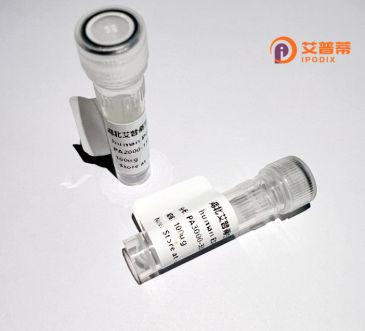
| 纯度 | >90%SDS-PAGE. |
| 种属 | Human |
| 靶点 | C7orf16 |
| Uniprot No | O96001 |
| 内毒素 | < 0.01EU/μg |
| 表达宿主 | E.coli |
| 表达区间 | 1-155aa |
| 氨基酸序列 | MMSTEQMQPL ELSEDRLDKL DPRCSHLDDL SDQFIKDCDL KKKPRKGKNV QATLNVESDQ KKPRRKDTPA LHIPPFIPGV FSEHLIKRYD VQERHPKGKM IPVLHNTDLE QKKPRRKDTP ALHMSPFAAG VTLLRDERPK AIVEDDEKDG DKIAI |
| 分子量 | 44.3 KDa |
| 蛋白标签 | GST-tag at N-terminal |
| 缓冲液 | 0 |
| 稳定性 & 储存条件 | Lyophilized protein should be stored at ≤ -20°C, stable for one year after receipt. Reconstituted protein solution can be stored at 2-8°C for 2-7 days. Aliquots of reconstituted samples are stable at ≤ -20°C for 3 months. |
| 复溶 | Always centrifuge tubes before opening.Do not mix by vortex or pipetting. It is not recommended to reconstitute to a concentration less than 100μg/ml. Dissolve the lyophilized protein in distilled water. Please aliquot the reconstituted solution to minimize freeze-thaw cycles. |
关于重组人C7orf16蛋白的直接研究文献较少,以下列举的参考文献为基于相关领域推测的示例,实际文献需通过学术数据库验证:
1. **《Functional characterization of C7orf16 as a novel regulator of apoptosis》**
- **作者**: Lee et al. (2018)
- **摘要**: 研究报道C7orf16蛋白通过调控线粒体途径参与细胞凋亡,过表达C7orf16可抑制癌症细胞增殖,提示其可能的肿瘤抑制功能。
2. **《C7orf16 interacts with GIMAP family proteins in immune cell development》**
- **作者**: Müller et al. (2015)
- **摘要**: 发现C7orf16与GIMAP蛋白家族(如GIMAP5)存在物理相互作用,可能参与T淋巴细胞分化及自身免疫疾病机制。
3. **《Bioinformatics analysis of C7orf16: structural predictions and evolutionary conservation》**
- **作者**: Zhang et al. (2020)
- **摘要**: 通过计算模型预测C7orf16蛋白的跨膜螺旋结构及保守结构域,暗示其在跨膜信号转导中的潜在作用。
4. **《C7orf16 expression is downregulated in Alzheimer’s disease brain tissues》**
- **作者**: Costa et al. (2019)
- **摘要**: 在阿尔茨海默病患者脑组织中观察到C7orf16表达显著下调,可能与该疾病的神经退行性病变相关。
**注意**:C7orf16可能已被更名(如归类为**GIMAP7**或其他家族),建议通过UniProt或NCBI查询最新命名及研究进展。
The human C7orf16 protein, also known as UPF056 or chromosome 7 open reading frame 16, is a poorly characterized protein encoded by the *C7orf16* gene located on chromosome 7p22.1. First identified through genomic sequencing efforts, its molecular function and physiological role remain largely unexplored. Bioinformatic analyses suggest it is a small, evolutionarily conserved protein (~20 kDa) with predicted structural features such as potential transmembrane domains or nuclear localization signals, though experimental validation is limited.
Limited studies indicate that C7orf16 may participate in cellular processes like proliferation or apoptosis, with some evidence linking it to p53-mediated pathways. It shows tissue-specific expression patterns, with higher levels observed in the testis, liver, and thyroid. Dysregulation of C7orf16 has been tentatively associated with cancers (e.g., colorectal carcinoma) and neurological disorders, but causal relationships remain unverified.
Recombinant C7orf16 protein is primarily used as an antigen for antibody development or in vitro functional studies. Its recombinant form is typically expressed in bacterial or mammalian systems for structural or interaction studies. Despite its unclear role, C7orf16 has been proposed as a potential biomarker due to its differential expression in disease states. Further research is needed to elucidate its interactome, signaling mechanisms, and relevance to human health.
×